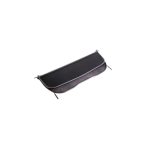Wind Deflectors
Wind deflectors for convertibles and roadsters calm wind noise and buffeting so top-down driving feels quieter and warmer. Start with Audi Wind Deflectors and Mercedes-Benz Wind Deflectors. OE-style mounts allow quick, usually tool-free installation and a secure, rattle-free fit.
Brief summary + key benefits
Wind deflectors are a high-impact upgrade for quieter, warmer top-down driving. By breaking up the recirculating airflow behind the front seats they reduce wind noise and buffeting, improve conversation clarity and make the heater feel more effective in cool weather. Properly engineered units use OE-style mounting points for quick, usually tool-free installation and a secure, rattle-free fit.
Technical Basics
Quality deflectors pair powder-coated aluminium or steel frames with fine mesh that redirects air without blocking rearward visibility. Rubberised interfaces protect trim and suppress squeaks, while discreet internal reinforcements keep the assembly stiff over rough surfaces. Good designs follow interior contours, sit flush and remain clear of the roof mechanism throughout its travel. Many models are two-position (deployed/folded) and fully foldable for easy stowage in a padded bag.
Explore brand-specific ranges for a perfect match: BMW Wind Deflectors and Peugeot Wind Deflectors.
Selection Criteria
Fitment: always match by model code and year range. Clip locations and trim geometry vary by generation; compare product photos to your interior before ordering. A model-specific solution ensures the quietest, most secure result.
Materials & durability: prefer powder-coated frames, UV-resistant mesh, damped hinges and abrasion pads at contact points. Corrosion-resistant hardware and serviceable joints help maintain long-term silence.
Use profile: benefits are most noticeable with two occupants. At motorway speeds reduced buffeting lowers fatigue; in town, less draught keeps the cabin calmer and warmer. If you often need rear-seat/boot access, choose a foldable design with a padded bag.
Appearance & integration: discrete black finishes blend with factory interiors; well-shaped frames keep mirrors and rearward sightlines unobstructed and require no permanent modifications.
Installation & Maintenance
Installation: position the frame, engage the clips and run a full roof test cycle to verify mechanism clearance. If any rattle appears, adjust clip tension or rubber interfaces. Do not place luggage on the deflector or attach non-approved accessories.
Care: soft-brush the mesh and wipe powder-coated frames with a damp microfibre cloth. Periodically check the coating for scratches, verify clip tightness and replace ageing rubber pads. Secure the folded assembly in the boot so it cannot slide under braking.
FAQ
Will a universal deflector fit?
Not recommended—model-specific units match interior geometry and mounting points for the best noise reduction.
Can it stay installed with the roof up?
Often yes—confirm clearances by cycling the roof after fitting to protect the roof mechanism.
How much noise reduction should I expect?
A clear drop in wind noise and buffeting; conversation and music become easier, especially with two occupants.
Are tools required?
Usually not—OE-style clips and supports allow quick, reversible installs.
How should I clean it?
Soft-brush the mesh and wipe the frame with a damp microfibre cloth; avoid harsh chemicals on powder coat.





